
“Today’s extremes could become tomorrow’s norms”
That’s the upshot of an ambitious study by the US Geological Survey, which would appear to affirm some dire predictions for California’s most important water system.
The study, authored by nearly a dozen scientists, is billed as “the first integrated assessment of how the Bay-Delta system will respond to climate change.” It’s presented as a “flash forward” to what California’s Sacramento-SanJoaquin Delta could become by the end of this century. It ran a series of nine indicators through multiple models to project trends in temperature, precipitation, salinity, runoff and sea level rise.
The result: Pretty much what climate scientists have been saying; that we’ll see “potentially longer dry seasons,” a shrinking Sierra snow pack and “earlier snowmelt leaving less water for runoff in the summer.”
“Our biggest reservoir in the state is our snowpack,” said Greg Zlotnick, who chairs the groundwater committee for the Association of California Water Agencies. “We’re going to get less snow, more rain, it’s going to run off more quickly, and that water will not be there late in the year.” Unfortunately, late in the year is when farms need it most for irrigation. Zlotnick says peak runoff has already shifted by about a month earlier in the season.
The study also tries to assess impacts from rising sea levels and increasing intrusion of salt water farther inland, and warned that “increased intensity and frequency of winter flooding could also occur as a result of earlier snowmelt and a shift from snow to rain.”
In a statement issued with the report, USGS Director Marcia McNutt called “protection” of California’s Bay-Delta system “a top priority for maintaining the state’s agricultural economy, water security to tens of millions of users, and essential habitat to a valuable ecosystem.”
Authors of the study ran their models under both rapid-and-moderate-warming scenarios developed by the UN’s climate panel. These yielded some differences in the outcomes. The authors write that those and other uncertainties in the process make it challenging for planners to respond to their projections. In their article for the open-access journal PLoS One, the researchers write that planners and risk managers “should anticipate shifts into regimes of environmental conditions unprecedented in the period of our social and economic development.”
In other words, the next 90 years will take us into pretty much unexplored territory.
6 thoughts on “Govt. Study Affirms Delta Fears, Water Risks for California”
Comments are closed.


Detailed prediction? Ha ha …..
Pick me a winner for the NFC East too……….
Growing population in California is a reality. The growing population will need more water, more energy, and more flood protection. Couple those needs with less snowpack and more rain and the only solution is construction of more multipurpose dams and storage reservoirs. Reservoirs will hold the runoff until needed by water consumers (ag and urban) and the environment. The water storage capacity will also protect against floods from the faster runoff produced by rain. Finally, the hydroelectric dams will produce clean electric energy without producing greenhouse gases.
Dr. KNO is absolutely correct, and my comments to Craig included that very point, but didn’t make the cut for the article. Investments in groundwater storage will be critical, along with surface storage to allow for optimal conjunctive use and increased management flexibility, to ameliorate the impacts of the loss of snowpack. It would be wrong, as some might potentially do, to interpret my comment as any indication that the reduction of water runoff later in the season is unmanageable or will require a reduction in agricultural activities in California — the 5th largest agricultural economy in the world.
Thanks, Greg. I felt that an explanation of conjunctive water management was a little beyond the scope of this post, the purpose of which was just to call attention to the USGS study.
We are very interested in this concept, however, as well as the future of California’s groundwater, and we are planning more explanatory coverage of this in the near future.
Upland forest management to reduce abnormally dense mixed conifer forests is the most important water resource management tool available to California since such forests are excessive water users well beyond what Nature intended. Overly dense forest stands are susceptible to drought and insect damage which increases fire hazard. More mid-elevation dams need to be constructed above anadromous fish migration habitats to store water formerly stored in snowpacks.
The environmental community is against such forest management because it wants reduced population in California as its primary goal. While this is laudable, it is not fair to burn and drought out folks living outside cities. Agenda 21 largely prescribes putting people back in multifamily housing in cities which is untenable.
John W. Menke, Ph.D., rancher in Siskiyou County and science advisor to Scott Valley Protect Our Water and Siskiyou County Water Users Association.
USGS Director Marcia McNutt was answering questions about the study on ZoPost:
http://www.zopost.com/07-Nov-2011/flash_forward_100_years_climate_change_scenarios